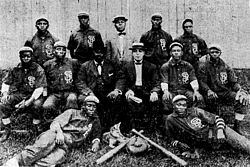| St. Paul Colored Gophers | |
|---|---|
| Information | |
| League |
|
| Location | Saint Paul, Minnesota |
| Ballpark | |
| Established | 1907 |
| Disbanded | 1914 |
| Nickname(s) |
|


The St. Paul Colored Gophers was a small club of black baseball players formed in St. Paul, Minnesota, in 1907. [1] They were not a formal Negro league team, as the commonly referred-to "Negro leagues" were not created until 1920. However, like other barnstorming teams of the time, they put considerable pressure on the desegregation of baseball. Historians rarely mention the Colored Gophers in Negro baseball history, and statistics are hard to find.